10 years journey into colour and form
Muswellbrook Regional Art Gallery , February 2004
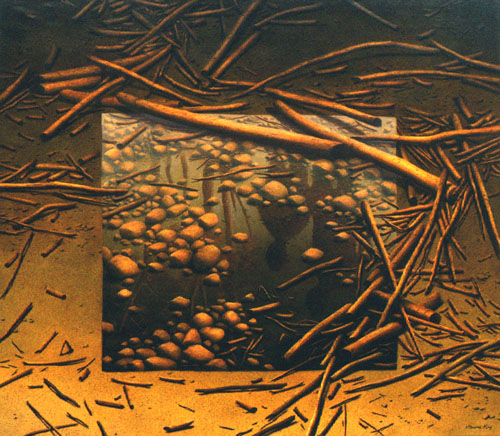
juxtaposition 4
The exhibition brings together a collection of about 40 artworks which were created between 1993 and 2003.
Although these art works were produced in Australia there are traces of journeys I made over decades in other continents, in other cultures and languages.
I try to find links.
My work is a bridge between memories of my childhood in Israel and my present preoccupation with being an artist in Australia ; between my role as a soldier in the 6 days war and as an art student in Vienna ; between life in New York and life in a small Australian village in the Upper Hunter valley.
.
I chose to name the exhibition ‘the playground’ to suggest a place in which imagination can be explored; a place where dreams and fears create patterns that leave their marks. I use pencils, ink, watercolour and oil paint to delve into those places
I like the immediacy of drawings and watercolours. It allows me to let elements grow spontaneously into metaphoric expressions, which in turn, intuitively connect personal and geographical landscapes. On the other hand the time consuming process of layering oil paint and egg tempera to achieve the luminosity I’m looking for, has become, among others, a dialogue with past art works and their makers.
RETURN
|
Echoes
Exhibition, Michael Nagy Fine Art, Sydney, 2002
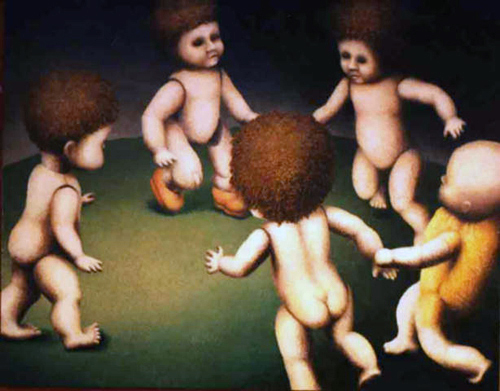
after the dance
A year ago I moved from Sydney to a small rural village. My studio is a very large renovated stable located in the middle of a paddock, and encircled by part of the Great Dividing Range. The intrusive sound of the railway, which runs alongside one edge of the property, echoes off the hills, and keeps me linked to the world at large, and to my artwork. Once the train has passed, the silence is even more pronounced, and it is then that other, unnatural, sounds intrude, bringing urban life into nature, the past into the present.
Thus from my rural studio I trace journeys made over decades, on other continents, in different cultures and languages. I try to find links. The art works act as a bridge between memories of my childhood in Israel and my present day preoccupation with being an artist in Australia. The immediacy of drawing has allowed me to let the elements grow intuitively into metaphoric expressions, which connect personal and geographical landscape, while the time consuming process of layering oil paint has become a dialogue with art works of past artists.
In this exhibition the paintings are a dialogue with Matisse’s work. At times the composition and the title make clear the connection, as in ‘after the dance’, ‘a game of balls’, and ‘intermission’. In other instances only the title is the connecting link, and the visual connection is extremely loose, as in ‘bathers with a frog’ and ‘la coiffure’. Instead of human figures I have used dolls, and my painting method is diametrically opposed to Matisse’s technique.
My writing about this work is about the process as I am aware of it. It is not about interpretation or meaning, which comes along later. My intention is that each image will evoke in the viewer a series of associations, ideas and aesthetic appreciation, which even if they are not necessarily rational will still make sense.
When I look at my art works and speculate about them, they baffle me too.
RETURN
|
Traces
Exhibition at Paul Greenaway, Adelaide, 1999
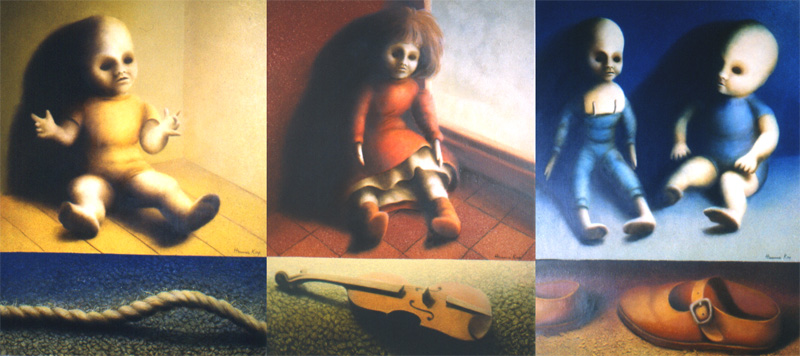
primary colours (yellow, red, blue)
I am assuming that any conscious arrangement of objects tells a 'story'. The interesting thing is there are always at least two possible 'stories' - one is the story I, as the artist, think I'm telling, the other is the story the viewer is reading into the same arrangement. In a sense, this interaction is a game in itself - a juxtaposition of stories. Through this interaction I want to trigger a process which destabilizes the psyche, and challenge certain cultural conventions that undermine the way we read objects and the traces they etch on our minds.
In series of oil paintings and pen and ink drawings I present fragmented images that form a web of relations with an absent factor, through which such conventions may be examined.
I can't explain, exactly, why I choose certain elements rather than others. The elements are deliberate: they are not explanations, justifications, or even solutions. Rather they represent sensations and a mode of thought at a particular moment, and are governed solely by my artistic interests.
The use of a shadow cast upon a landscape enables me to introduce an action which is taking place outside the canvas. The Juxtaposition series is an attempt to balance alternative dimensions in which the image has no limits. Life in the city has inspired the ‘Recent Ruins’ series. Life in the city is a constant jumble of jarring opposites - beauty and ugliness, intelligence and ignorance, spontaneity and regulation, order and chaos. In my latest work, I set out to examine this mixture of diverse forces through the games children play. There I explore objects that somehow relate to the mythology behind a child's play, and the boundaries of their meaning.
RETURN
|
Games
Exhibition at Michael Nagy Fine Art, Sydney, 1998
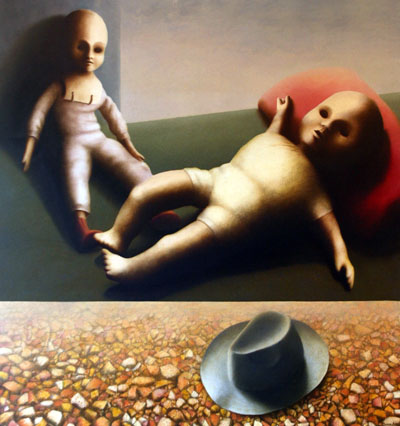
jabberwocky
The works in the exhibition are the result of my preoccupation with the world of children, in particular the games children play. I am interested in exploring objects that somehow relate to the mythology behind a child’s play, and in looking at the boundaries of their meaning.
I started with individual objects and images that I have been in my childhood memories for years, unimportant things with personal resonance. I did not know what the resonance was. I just knew that I carried these things within me, and I started to examine what they might signify.
I wanted to explore objects that can refer both to concepts and ideas beyond themselves and their standard functions. Objects that refer to ideas that may situate them in a new space. What I produced is a non-linear series of thoughts – an incomplete and non-hierarchical arrangement of individual units.
I am assuming that any conscious arrangement of objects tells a ‘story’. The interesting thing is that there are always at least two possible ‘stories’ – one is the story I, as the artist, think I’m telling, the other is the story the viewer is reading into the same arrangement. In a sense, this interaction is a game in itself that is a juxtaposition of stories. Through this interaction I want to challenge certain conventions of Western culture that undermine the way we see objects. My work presents fragmented images that form a web of relations, through which such conventions may be examined.
RETURN
|
The Playground
Commissioned by the Sydney Festival, 1997

urban playground 200 x 1000cm
For me, life in the city is living among jarring opposites, complex tensions that rise above the personal and the particular. What makes city life exciting is constantly juggling beauty and ugliness, intelligence and ignorance, spontaneity and regulation, order and chaos, and nevertheless, staying sane.
I set out to examine this mixture of diverse forces through the games children play. Hopscotch, skipping, jacks, knuckles, bats and stones have etched themselves into that mythological realm of our childhood; the playground. A fragmented landscape has evolved around the marks left upon us. And, whilst the playground was originally conceived in order to keep children off the streets, paradoxically, in modern times the streets are now the playgrounds that sustain the marks we make on them.
RETURN
|
Hop, Skip, and Jump
Exhibition at Paul Greenaway Gallery, Adelaide, 1996
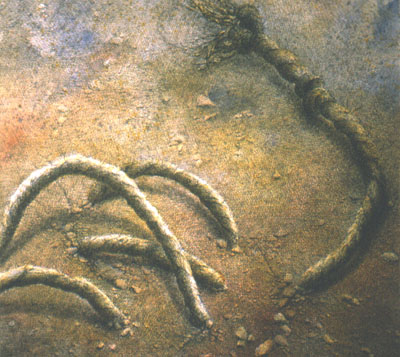
a loop
It was part of my intention to examine the games children play - hopscotch, skipping ropes, five stones (jacks), etc., - all of which have etched themselves into the mythology of my childhood, and thus served as a starting point for this body of work.
I set out to explore my recollections, using explicit instances to look at experiences that resonate familiarity. Through this I hoped to find a transparent landscape that would transcend the personal and the particular; a landscape which would sustain the marks made on us, and the marks we make.
As the works neared completion, I was intrigued to find sinister, almost malevolent, feelings lurking within them. My original intentions were to look through the lighter aspects of childhood; to provide topography of a sunny blameless landscape. Instead, it seems that what has evolved is a paradox of innocence revealing a menacing face.
RETURN
|
|





